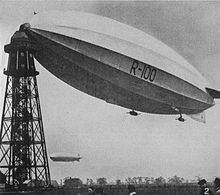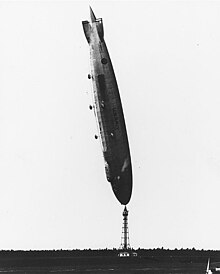Anchor mast

A mooring mast is the anchoring of airships to the ground (less common occurrence on ships). It is always used when the airship is not housed in an airship hangar .
Functionality and handling
General
Similar to a seagoing ship, airships also have to be anchored if they are to be prevented from drifting away. The airship is connected to the top of the mast from the bow. For this purpose, most airships have a reinforced bow with a mooring point. When the airship is “parked” on the mast, the ship can turn freely around the mast into the wind. In this way, large wind loads on the ship and the mast are avoided.
The mast is not normally used when the passengers are simply changed, but the ship is placed against the mast, for example for refueling. For longer stays on the mast, the mast vehicle can be guyed, i.e. it can also be attached to the ground. This is necessary in order to guarantee a high level of stability of the mast even in poor or windy weather.
Mooring maneuvers
Since airships are very large, relatively sluggish, susceptible to wind and therefore cannot be precisely steered on the ground, they are pulled to the anchor mast when landing. Most airships have a rope on the bow cone that hangs down freely or is rolled up during travel. In the large historical rigid airships, the bow was accessible from the inside so that a crew member could deploy the rope (s). The anchor rope is attached in the middle of the bow cone, which fits into the corresponding funnel on the anchor mast. It is pulled over a deflection at the top of the anchor mast. In this way, the airship can be guided for the last few meters until it is docked. The bow cone of the airship is then locked in the rotating funnel at the top of the anchor mast.
Construction
High mast
The concept of the high mast, which was particularly widespread in England and the USA, was based on the idea of not letting the airship land at all, but only of mooring it and transferring people and materials via a hatch in the bow. One disadvantage, however, was that the ship had to remain manned at all times in order to compensate for changes in lift, for example due to temperature changes.
In the case of the two British airships R100 and R101 , entry into the ship was planned from the start via a jetty under the bow anchorage. Normally this area was only accessible to the crew. Inside, a walkway then led to the passenger compartments (see picture).
Rail-guided masts
In the great historical rigid airships to move the ship had on the ground, such as the or unhangaring to lead to more than two hundred workers the ship with muscle power. On the rigid airships of the 1930s, therefore, u. a. Rail- guided masts for the bow and trolleys for guiding the stern (rear wagon) tested. The lower tail fin or the rear engine nacelle were attached to the rear car. When "parking" at the anchor mast, it could roll around the mast on a circular track. He followed the direction of the ship into the wind while keeping the stern on the ground. Nevertheless, the ships were first “caught” by the ground crew on landing and led to the mast.
The American impact airships of the US Navy were moved in the 1950s with rollable anchor masts, in front of which a tractor was stretched, on the airfield and in the hangars. This principle is also used today in the Zeppelin NT and the Skyships, where the mast is mounted on a truck.
On ships
In 1924 the US Navy fitted the oil tanker USS Patoka with an anchor mast for airships. On this mast, the American airships laid z. B. during maneuvers with the fleet. Since both ships were traveling at a certain speed, it was easier for the airship to maneuver to the anchor mast than is the case with a fixed mast on land.
At skyscrapers
There were concepts to allow airships to dock on skyscrapers . The top of the Empire State Building , which opened in 1931, was originally intended to serve as an anchor mast. The mast was stiffened so that it could have withstood the 50 ton pull from the airship anchorage. Some of the winches were already installed and the 86th floor was prepared as a departure lounge with a ticket counter and customs control. The idea corresponded to the euphoria for the giants of the air at the time . During the construction, however, it was not taken into account that airships can only be maneuvered very slowly and that wind turbulence always occurs due to the development , which could have seriously disrupted an airship. The airships of that time also used water as ballast , which was often given off during landing maneuvers to compensate for lift or trim . This water, sometimes several hundred liters at a time, could then have poured into the street canyons of New York. It was therefore only a few attempts by American naval airships to approach this anchor mast. An actual landing maneuver never took place. The risk of an accident over the crowded streets would have been too high.
On trucks

In modern, relatively small airships, the mast is often mounted on a truck . So it is transportable and can, for. B. be driven to the places from which the airship operates. With a movable mast, the coupled airship can also be moved on the ground without great personnel expenditure. This construction is already documented in 1930, when Goodyear fitted a Ford Model AA with a foldable mast on the west coast. In addition, booms were mounted on the vehicle to prevent it from tipping over. On the east coast, a similarly converted Buick bus was in service for the airship operator.
Height adjustability
Modern anchor masts are height adjustable. The anchor mast of the Zeppelin NT can be extended up to a length of 13 m. For example, the lowering of the bow when the stern is suddenly raised can be compensated for. While mooring, the pilot pushes the ship to the ground and lets the winch pull it towards the mast. The pull rope is kept taut to avoid sudden loads. Other impact airships still have to be maneuvered to the mast by hand with a ground crew of around 20 people on the ground.
Historical
Spread of anchor masts
Airship masts were built in many cities in the 1920s and 1930s to allow airships to stay. These masts were also cited as an advantage of airships over airplanes, as they practically represented the only infrastructure , apart from an open field , that an airship needed to land.
"Headstand" on the anchor mast
The USS Los Angeles , an airship of about 200 m in length, fully led a probably unique in the history of technology feat on August 25 1927th It was on the so-called high mast , a mast on which the airship was moored very high above the ground, in Lakehurst . The stern was raised by a gust of wind and got into a cooler layer of air. Despite the immediate shift in weight of the crew on board, the increased buoyancy of the warm lifting gas led to a further rise in the stern until the ship was almost vertical. This incident led the US Navy to abandon the concept of the high mast in favor of lower structures.
Preserved anchor masts
Two of the anchor masts used for the polar expeditions by the Norge in 1926 and by the Italia in 1928 , both keel airships by Umberto Nobile , can still be seen in Ny-Ålesund on Spitsbergen and in Vadsø (Norway) .
The only remaining and completely preserved anchor mast of the transatlantic traffic from 1930 is the Zeppelin Tower in Recife , the capital of the Brazilian state of Pernambuco . On May 21, 1930, the LZ 127 “Graf Zeppelin” anchored on her first voyage to Brazil. This was the beginning of a successful route between Germany ( Frankfurt am Main ) and Brazil (Recife - Rio de Janeiro ) between 1930 and 1938. During this time the LZ 129 “Hindenburg” anchored four times and the LZ 127 “Graf Zeppelin” five times . The anchor mast is about 10 minutes from the Mangueira Metrô station and is located on a guarded military site and can be viewed upon request. It has been restored several times so far.
literature
- Peter Kleinheins, Wolfgang Meighörner (ed.): The large zeppelins 3rd edition. Springer, Berlin Heidelberg 2005, ISBN 3-540-21170-5, especially Chapter 9 "Driving, landing and anchoring" on pages 124-137
Web links
Individual evidence
- ↑ http://vintageairphotos.blogspot.de/2015/03/volunteer-at-rest.html accessed on December 24, 2016



